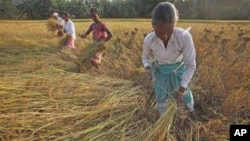Five months after lifting a ban on exports of cheaper varieties of rice, India has emerged as one of the world's top rice exporters. That has helped stabilize prices around the world, even as the cost goes up in traditional exporting nations like Thailand.
Scores of Indian rice traders have returned from a recent Grains Conference in Dubai after discussing lucrative deals.
Brisk business expected
The head of the All India Rice Exporters Association, Vijay Setia, says business will be brisk in the coming months.
"Feeling was bullish. Demand from Iran, Iraq and the entire Middle East was big. African customers were there because of good quality and the lower price," said Setia.
The reason: India is providing customers with a cheaper alternative to rice from top exporters like Thailand. Rice became more expensive in Thailand after floods damaged last year's crop and the government introduced a scheme to guarantee how much farmers are paid.
Effect of lifting on exports
The situation in India is dramatically different. There are huge stockpiles after a series of bumper rice crops, leading to a nearly 25 percent fall in paddy prices in local markets.
The government responded in September by lifting a four-year-old ban on exports of lower-priced varieties of rice. India has always exported its expensive "basmati rice," but exports of other varieties were suspended in 2008 after global food prices climbed steeply.
Samarendu Mohanty, chief economist at the International Rice Research Institute in Philippines, says India’s return to the global rice market in September prevented a spike in international prices.
"India came as a savior. The timing was so perfect because Thailand was implementing in the same month their rice mortgage program where they increased their domestic price by nearly 50 percent. It pretty much boiled down to if Thai increased their rice by 50 percent, then global rice price also goes up accordingly. But that did not happen because of India," said Mohanty.
Price advantage
Mohanty estimates that a ton of Indian rice is currently about $100 cheaper than comparable varieties from other countries. From October to January, India shipped out 2.3 million tons of rice - even more than Thailand - as the Indian rice was sought by customers in several countries.
Those customers include neighboring Pakistan, which is itself a rice producer and exporter. The price advantage has prompted Pakistani traders to buy rice from Indian traders for the first time.
R.S. Seshadri, director at a leading rice exporting company, Tilda Riceland, says more rice is also going to price-conscious markets in Africa.
"Today you are able to participate in the entire price spectrum of rice trades in the world. Otherwise, previously you were restricted only to the premium $900 [per ton] plus rices. Today you are able to participate in the $350 till a $1,000 (per ton) rice export," said Seshadri.
Upbeat assessment for future
According to industry estimates, India’s share in the global rice trade could triple this year and rise to about six million tons.
Setia of the Rice Exporters Association points out that India’s granaries are overflowing.
"India is overloaded with rice. In four years, we have accumulated our buffer stock 30 million tons, which is very large. Similarly, the private traders are also loaded with rice," said Setia.
That spells good news for global consumers, says Mohanty at the International Research Rice Institute.
"If India stays in the market, and we don’t have any big weather crisis in Asia, I would expect prices to go down little bit," said Mohanty.
Exports from India are expected to continue this year as there is virtually no space in Indian granaries to store more rice.
Future exports hinge on harvest
However, Seshadri of Tilda Riceland says much will depend on the size of India's rice harvest this year.
"The window of review will be in May when the first estimates of monsoons are put out. India will determine whether it needs to tighten or loosen its export policy. There will never be a situation where India cannot take its eye off the ball because internal consumption is so large that one cannot but keep a very close eye on it," said Seshadri.
India is the world’s second largest rice producer. But with 1.2 billion people to feed, rice exports are only permitted after the government stores sufficient surplus to meet emergency needs such as a crop failure due to drought.








